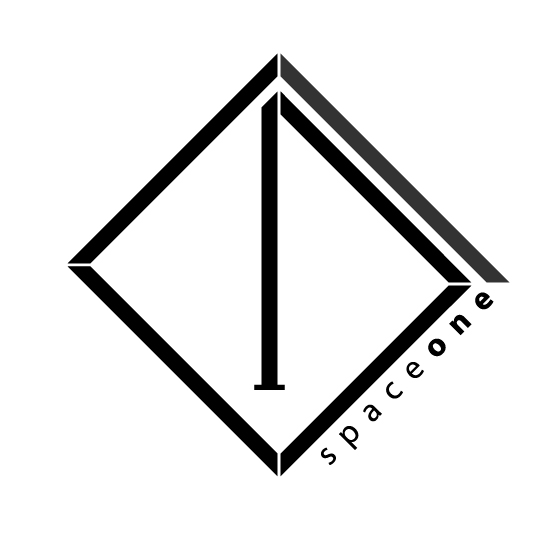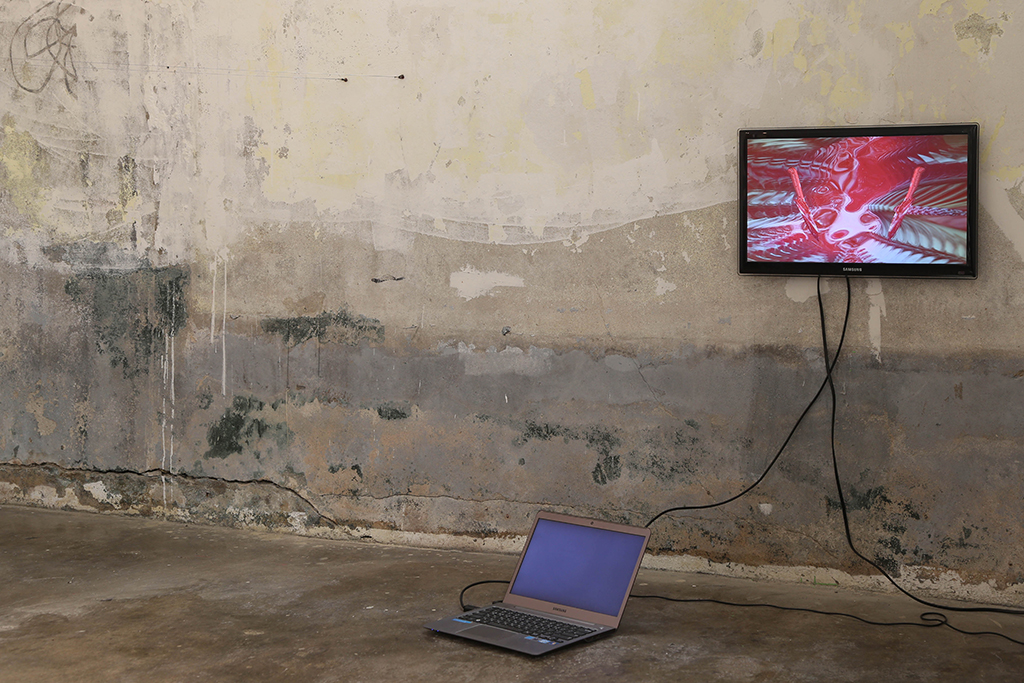응시하다 그리고 음미하다/ the taste of gazing
스페이스 원 이번 전시, '응시하다, 그리고 음미하다'의 정승과 폴 쥐르크(Paul Zuerker)의 작업은 일상의 오브제를 소재로 한다. 두 작가는 일반적으로 주목하는 오브제의 물성(物性) 이면에 존재하는 사회적 배경과 관련된 이야기들을 은유적으로 다루고 있다. 영상, 설치 그리고 조각을 매개로 오브제의 구조를 분석하고, 전혀 다른 물질들과 병치(竝置)를 시도하거나, 인문학적 의미를 부여하는 등의 과정을 거친다. 이렇게 작가가 설정한 오브제는 인간의 내면과 사회의 변화를 비유적으로 담아내는 스펙터클로 새롭게 탄생한다. 서로 다른 기술의 적용을 요구하는 두 작가의 작업의 특성은 갈수록 복잡해져 가는 현대사회를 담아내기 위해 다양한 실험을 시도하는 동시대 작가들의 모습을 대변한다고 할 수 있다.
정승의 작품은 수백 개의 멀티탭을 공중에 이어 붙인 설치작품이다. 작은 움직임 만으로 굴러다니거나 흔들흔들 움직이는 구(球)형태의 오브제를 연결하여 완성된다. 기존의 ‘Multi Complex’ 시리즈의 연장선 상에서 우주를 구성하는 최소 단위가 구나 점의 형태가 아닌 띠의 형태를 하고 있을 것이라는 물리학이론인 ‘끈이론(string theory)’을 모티브로 한 구조를 시도했다. 우리가 사는 21세기의 사회는 의미를 파악하기 힘든 복잡함을 끊임없이 만들어내는데, 정승은 시작점을 알 수는 없어도 일단 그 나름의 정리를 시작한다. 그의 작업에는 지나치게 비대해져 가는 현대 도시사회의 시스템에 대한 비판적 시선을 표현한 지극히 현실적인 내러티브가 들어있다. 멀티탭 구조물과 기하학적인 형체에서 연상되는 추상성의 결합, 그리고 분명 존재하지만 눈에는 보이지 않는 양자역학 이론까지 뒤엉키며 공허함에 대한 메시지를 전달한다.
폴 쥐르크는 영상과 함께 두 개의 칼이 설치된 작품을 선보인다. 그는 영상 안에서 3D 오브제가 작동하는 모습을 실시간으로 보여준다. 영상 안에 하나의 오브제는 배경과 함께 맞물려 합쳐지는 피드백 고리(feedback loop)로 인해 단일한 구조물을 터뜨리고, 느슨하게 하는 액화된(liquidated) 고기의 진동 시뮬레이션이며, 또 다른 오브제는 고기 살점의 질감으로 된 칼을 모델로 한다. 이 칼은 유동성과 상호 연관성을 가지고 괴상한 행동과 형태로 으스러진다. 두 개의 칼 설치물은 개인적인 흔적을 담고 있으며, 실제 칼은 한국의 산업화를 반영한다. 그것은 폭력의 대물림의 과정이다. 우리가 사용하는 대부분의 칼은 포드주의적 방식에 기반을 둔, 통제 과정을 통해 체계화된 방식으로 제작되는 반면, 3D 프린터로 생산된 칼은 인체공학 의자에 앉아 그 앞의 평면 스크린 속의 상품을 클릭하여 제작된다. 인쇄된 3D 칼은 마치 성형수술을 통해 아름다움을 각인하듯 칼날에 '아름다움'이라는 장식적 문구가 새겨져 있다. 두 개의 칼 끝은 서로 맞닿아있다. 서로 다른 속성과 과정을 통해 만들어진 두 칼은 한국사회를 잘라낸 단면을 통해 경제과 미디어, 그리고 한국인들의 상호관계가 변화하고 결속하는 전형을 보여준다.
정승과 폴 쥐르크는 더 나아가 스페이스 원의 공간적 특징에 반응하는 새로운 작업을 함께 선보인다. 정승은 두 조각 신작을 통해 현대 도시 사회 속에서 생존을 이어가는 현대인의 감성을 담은 메시지를 공유하는데, 이는 어디서부터 시작해야 할지는 모르지만 분명 정리가 필요해 보이는 현대인의 절박한 심정이다. 서로의 목이 달라붙은 채 발버둥 치는 아기 인형들(No Title(2016) I)을 비롯하여 아기 인형의 머리에 여러 개의 금속봉이 박혀있는 형상(No Title(2016) II)의 작품들을 소개한다. 폴 쥐르크는 스페이스 원 주위에 있는 사람들의 소리를 녹음한다. 쥐르크에게 3D 칼은 마치 영원한 미소를 짓고 있는 서비스 지향적인 사회를 반영하는 반면, 실제 칼은 ‘쉬이이이이익”하는 한국의 노인들이 목에서 나는 소리를 연상시킨다. 이 소리는 주위에 환경의 급격한 변화와 함께 사라지는 듯 하지만, 동시에 스페이스 원 공간 안에서 작지만 분명하게 머무르고 있다.
Space One presents 'The Taste of Gazing' by Jung Seung and Paul Zuerker. Both artists base their works on everyday objects. In the user's point of view, everyday objects are merely tools. This focus on functional attributes doesn’t allow any other perspectives. May it be a cultural specific history, its process of production or the potential for redefinition, the objects hold hidden traces that are unrecognizable at first glance. Yet there is a demand in the objects that influence the world’s perception of their users. When the objects take shape, they sculpt our everyday life, too. The objects spark conversations, which in turn create a peephole of something different. Their materiality works as a living organism growing its mediated immateriality in a discursive praxis. They are message-driven artworks that demand the visitor’s engagement without any definite conclusion.
In Jung Seung's installation work, numerous extension cords are assembled together like millipedes, meeting at their joints and hanging in air. The cords are connected to a sphere on the ground, which rolls when it detects an approach. As the fourth edition of 'Multi Complex' the artist creates a string-shaped structure, inspired by the string theory. The Multi Complex series represents the artist's criticism on modern society that consistently amplifies its structure without any apparent purpose. The jumble of social criticism, abstraction and invisible quantum mechanical ideas deliver a message in vain.
Paul Zuerker's work is an installation of video accompanied by two knives. The video shows a live streaming of 3-D objects. One object is a pulsating simulation of liquid meat that bursts and looses its singular structure knitting into the background. The other 3-D object is a model of a knife. With a meat-like texture, it moves and changes its shape with a certain fluidity and interconnectivity. Among the two knives, the manufactured steel knife is a source of reflection on the industrialization in Korea. It inherits violence of modernity witnessed from its rough and raw surface, as it is produced in a systematic, organized, and disciplined industrial process. The 3-D printed knife is, on the other hand, produced by a person who sits on an ergonomic chair in front of a flat screen monitor and clicks a button. The inscription on the 3-D printed knife refers to 'beauty' in a plastic surgery. In their materiality and hidden processes, the two knives exemplify a cut inside of Korean society and the interrelated shift of its economy and media.
Furthermore, in response to Space One's surroundings, the two artists create new site-specific works together. Jung invites the audience to talk about their sensitivity as an individual who continues to survive in this seemingly absurd modern society. His new sculptures, ‘No Title 2016 I’ is two headless baby dolls conjoined at the neck and shaking nervously; ‘No Title 2016 II’ is a head of baby doll with protruding steel rods. Zuerker's sound work is a collection of voices from the people around Space One. While the plastic knife resonates a service-oriented society with its ever-frozen smiles, the real knife evokes a certain viscerality with its 'rrgghsssshshtshghh'-throat sound. The sound, separated and rapidly dissipating from Korean society, haunts the space in its materiality.
작가소개/Artist intro:
정승작가는2006년 파리 세르지 국립미술학교에서 학업(석사)을 마치고 귀국 후 현재까지 서울에서 작업을 진행해 오고 있다. 지금까지 선보였던 작업들의 큰 주제는 기계적 사상에 길들여져 있는 현대인들의 단면들을 냉소적인 시각으로 바라보는 것이 주를 이루었다. 최근 국립현대미술관서울관 개관기념 야외조각 프로젝트를 비롯해 Korea-NRW Transfer(Kunstmuseum Bonn), Plastic Garden(East gallery,베이징) 등을 통해서 작품 활동을 이어가고 있다.
폴 쥐르크의 작업은 인간의 몸과 그것의 외부와의 불변명한 경계선에 집중하고 있다. 문맥에 맞지 않게 세팅된 재료로 이루워진 그의 조각작품은 몸과 연결되는 테크놀로지와 새로운 미디어에 대한 질문을 던진다. 그는 최근에 청주미술창작스튜디오(2016)에서 개인전 <alien – identity>을 개최하였고; <me:alien> 인천아트플랫폼 (2015), Frappant 갤러리, 함부르크”(2013)에서 콜라보 프로젝트 <this is the subject we have>와 <decalcomania>에 참여하였다. 그 외에도 텔-아비브에 Alfred 갤러리, 함부르크, 서울에 위치한 자하미술관, 진갤러리등 2013년부터 현재까지 국제적인 활동을 하고 있다.
Jung Seung's work focuses on the system of contemporary capitalistic society. He seeks for an answer as to how one survives in the present society. He has produced solid and consistent body of work with these concepts from 2007 until 2016. Some of his recent major shows include: 'Plastic Garden', East bridge (798), Beijing, China, 'New Romance' (Korea-Australia exchange), MMCASeoul, Korea, Inauguration of MMCA Seoul (Out door sculpture project), Seoul, Korea.
Paul Zuerker's work focuses on blurring lines and boundaries of human body and its alien exteranl parts. It touches upon questions around technology and new media connected to the body as a discursive sculpture influenced by material settings. Some of his recent exhibitions include: solo exhibition, 'alien - identity' at CJAS in Cheongju (2016); 'me:alien' at Incheon Art Platform (2015); collaboration project, 'this is the subject we have' and 'decalCOmania' (2013) at Frappant Gallery in Hamburg (2015); two person shows at Alfred Gallery in Tel Aviv (2014), Zaha Museum in Seoul (2015); City Hall of Hamburg (2013); group shows i.e. at Zaha Museum (2016), Jean Gallery (2016) in Seoul.







